Correct Answer

verified
Correct Answer
verified
Multiple Choice
The demand for a product is inelastic with respect to price if
A) consumers are largely unresponsive to a per unit price change.
B) the elasticity coefficient is greater than 1.
C) a drop in price is accompanied by a decrease in the quantity demanded.
D) a drop in price is accompanied by an increase in the quantity demanded.
Correct Answer

verified
Correct Answer
verified
Multiple Choice
The price-elasticity coefficients are 2.6, 0.5, 1.4, and 0.18 for four different demand schedules,D₁, D₂, D₃, and D₄, respectively. A 2-percent increase in price will result in an increase in total revenues in which of the following cases?
A) D₁ and D₃
B) D₁ and D₄
C) D₂ and D₄
D) D₁, D₂, and D₃
Correct Answer

verified
Correct Answer
verified
Multiple Choice
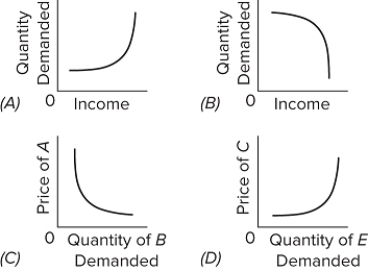 Refer to the diagrams. In which case would the coefficient of income elasticity be positive?
Refer to the diagrams. In which case would the coefficient of income elasticity be positive?
A) A
B) B
C) C
D) D
Correct Answer

verified
Correct Answer
verified
Multiple Choice
Which of the following is correct?
A) If the demand for a product is inelastic, a change in price will cause total revenue to change in the opposite direction.
B) If the demand for a product is inelastic, a change in price will cause total revenue to change in the same direction.
C) If the demand for a product is inelastic, a change in price may cause total revenue to change in either the opposite or the same direction.
D) The price elasticity coefficient applies to demand, but not to supply.
Correct Answer

verified
Correct Answer
verified
Multiple Choice
Suppose the income elasticity of demand for toys is -2.5. This means that
A) a 3 percent increase in income will decrease the purchase of toys by 7.5 percent.
B) a 3 percent increase in income will decrease the purchase of toys by 1.2 percent.
C) a 3 percent increase in income will increase the purchase of toys by 7.5 percent.
D) toys are a normal good.
Correct Answer

verified
Correct Answer
verified
Multiple Choice
Assume that a 3 percent increase in income across the economy produces a 1 percent decline in the quantity demanded of good X. The coefficient of income elasticity of demand for good X is
A) negative, and therefore X is an inferior good.
B) negative, and therefore X is a normal good.
C) positive, and therefore X is an inferior good.
D) positive and therefore X is a normal good.
Correct Answer

verified
Correct Answer
verified
Multiple Choice
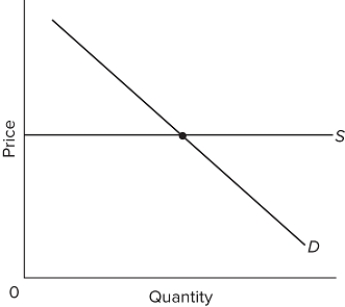 Refer to the above graph. If the demand increased, then
Refer to the above graph. If the demand increased, then
A) price and quantity would both increase.
B) price and quantity would both decrease.
C) price would stay the same and total revenues of sellers would stay the same.
D) price would stay the same and total revenues of sellers would increase.
Correct Answer

verified
Correct Answer
verified
Multiple Choice
The state legislature has cut Gigantic State University's appropriations. GSU's Board of Regents decides to increase tuition and fees to compensate for the loss of revenue. The board is assuming that the
A) demand for education at GSU is elastic.
B) demand for education at GSU is inelastic.
C) coefficient of price elasticity of demand for education at GSU is unity.
D) coefficient of price elasticity of demand for education at GSU is greater than unity.
Correct Answer

verified
Correct Answer
verified
Multiple Choice
 Refer to the table. Over the $10-$8 price range, the elasticity coefficient of supply is
Refer to the table. Over the $10-$8 price range, the elasticity coefficient of supply is
A) 1.
B) zero.
C) less than 1.
D) greater than 1.
Correct Answer

verified
Correct Answer
verified
Multiple Choice
The narrower the definition of a product,
A) the larger the number of substitutes and the greater the price elasticity of demand.
B) the smaller the number of substitutes and the greater the price elasticity of demand.
C) the larger the number of substitutes and the smaller the price elasticity of demand.
D) the smaller the number of substitutes and the smaller the price elasticity of demand.
Correct Answer

verified
Correct Answer
verified
Multiple Choice
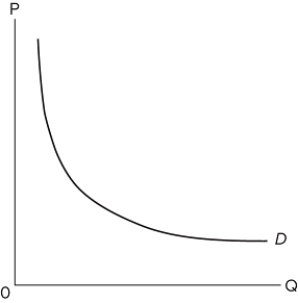 Refer to the diagram, which is a rectangular hyperbola, that is, a curve such that each rectangle drawn from any point on the curve will be of identical area. In comparing the price elasticity and the slope of this demand curve, we can conclude that the
Refer to the diagram, which is a rectangular hyperbola, that is, a curve such that each rectangle drawn from any point on the curve will be of identical area. In comparing the price elasticity and the slope of this demand curve, we can conclude that the
A) slope of a demand curve measures its elasticity.
B) elasticity of a demand curve measures its slope.
C) slope and elasticity of the curve are both constant throughout.
D) slope of the curve varies, but its elasticity is constant.
Correct Answer

verified
Correct Answer
verified
Multiple Choice
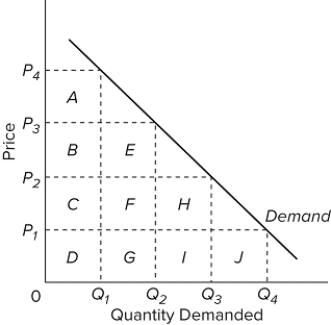 Refer to the above graph. If the price increases from P₁ to P₂, then the total revenue will gain area
Refer to the above graph. If the price increases from P₁ to P₂, then the total revenue will gain area
A) B + E, but it will lose area H + I + J.
B) C + F + H, but it will lose area J.
C) E + F + G, but it will lose area J.
D) A + B + C, but it will lose area G + I + J.
Correct Answer

verified
Correct Answer
verified
Multiple Choice
A glass company making windows for houses also makes windows for other things (cars, boats, stores, etc.) . We would expect its supply curve for house windows to be
A) dependent on the demand for boat and plane windows.
B) no different from that of firms which make only house windows.
C) relatively more elastic than those of firms that make only house windows
D) relatively more inelastic than those of firms that make only house windows
Correct Answer

verified
Correct Answer
verified
Multiple Choice
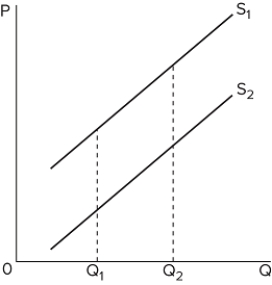 The diagram shows two product supply curves. It indicates that
The diagram shows two product supply curves. It indicates that
A) over range Q₁Q₂, price elasticity of supply is greater for S₁ than for S₂.
B) over range Q₁Q₂, price elasticity of supply is greater for S₂ than for S₁.
C) over range Q₁Q₂, price elasticity of supply is the same for the two curves.
D) not enough information is given to compare price elasticities.
Correct Answer

verified
Correct Answer
verified
Multiple Choice
Suppose the income elasticity of demand for toys is +2.4. This means that
A) a 4 percent increase in income will increase the purchase of toys by 9.6 percent.
B) a 4 percent increase in income will increase the purchase of toys by 1.67 percent.
C) a 4 percent increase in income will decrease the purchase of toys by 9.6 percent.
D) toys are an inferior good.
Correct Answer

verified
Correct Answer
verified
Multiple Choice
If the demand for product X is inelastic, a 4 percent decrease in the price of X will
A) decrease the quantity of X demanded by more than 4 percent.
B) decrease the quantity of X demanded by less than 4 percent.
C) increase the quantity of X demanded by more than 4 percent.
D) increase the quantity of X demanded by less than 4 percent.
Correct Answer

verified
Correct Answer
verified
Multiple Choice
A consumer's weekly income is $550, and the consumer buys 9 bars of chocolate per week. When weekly income increases to $600, the consumer buys 10 bars per week. The income elasticity of demand for chocolate by this consumer is about
A) 1.82.
B) 0.83.
C) 1.
D) 1.21.
Correct Answer

verified
Correct Answer
verified
Multiple Choice
Answer the question based on the following data.  Over which of the following price ranges is the demand unit-elastic?
Over which of the following price ranges is the demand unit-elastic?
A) $18-16
B) $16-$14
C) $14-$12
D) $12-$10
Correct Answer

verified
Correct Answer
verified
Multiple Choice
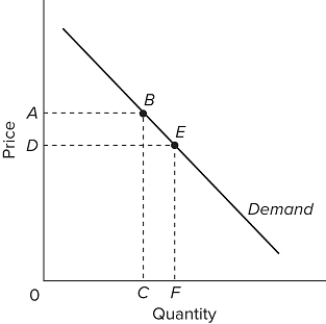 Consider the demand curve above. If area 0ABC is smaller than area 0DEF, we may conclude that demand in this range is
Consider the demand curve above. If area 0ABC is smaller than area 0DEF, we may conclude that demand in this range is
A) price-inelastic.
B) income-inelastic.
C) price-elastic.
D) income-elastic.
Correct Answer

verified
Correct Answer
verified
Showing 141 - 160 of 399
Related Exams